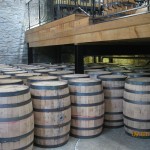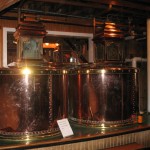Spend a week roaming around the land between Louisville and Lexington, Kentucky and you get an appreciation of the awesomeness of nature and the amazing ability of man to harness, use and  exploit what nature gives. The state of Kentucky, well, the part in the north middle at least, sits on limestone. The limestone
exploit what nature gives. The state of Kentucky, well, the part in the north middle at least, sits on limestone. The limestone filters the natural aquifer, providing pure clean water for distilling bourbon and calcium in the soil for that wonderful bluegrass. That calcium makes for stronger, faster racehorses and an industry that defines what thoroughbred horses are all about. And, while we didn’t see any of the grass as blue we did taste the bourbon.
filters the natural aquifer, providing pure clean water for distilling bourbon and calcium in the soil for that wonderful bluegrass. That calcium makes for stronger, faster racehorses and an industry that defines what thoroughbred horses are all about. And, while we didn’t see any of the grass as blue we did taste the bourbon.
As much as the limestone base is essential to racehorses and bourbon, it is the weather that aids in the distilling of bourbon. Weather that can go from hot and steamy to cold and icy. A pparently, a mash bill made of at least 51% corn, rye or wheat and
pparently, a mash bill made of at least 51% corn, rye or wheat and  barley just loves that kind of weather. Especially if it’s stored in virgin white oak charred barrels and left to sit, rest as they say in Kentucky, for at least four years in big old warehouses with little light, lots of windows and racks upon racks, most up seven stories. The fastest aging bourbon is on the top, where the extremes of weather are most profound. The process starts with the mash bill, and it is a legal recipe. According to a 1964 law, to be bourbon,
barley just loves that kind of weather. Especially if it’s stored in virgin white oak charred barrels and left to sit, rest as they say in Kentucky, for at least four years in big old warehouses with little light, lots of windows and racks upon racks, most up seven stories. The fastest aging bourbon is on the top, where the extremes of weather are most profound. The process starts with the mash bill, and it is a legal recipe. According to a 1964 law, to be bourbon, the spirit must be made of at least 51% corn. Most use rye as the second grain, giving bourbon that spicy in-the-front-of-the-mouth taste. Some, like Maker’s Mark, use wheat, a sweeter grain, and a smoother sip. When you walk into a warehouse you are greeted with a strong aroma. The distillers call that angel’s share the evaporated portion of the barrel as it rests in the warehouse. It’s sweet, not overpowering but definitely there.
the spirit must be made of at least 51% corn. Most use rye as the second grain, giving bourbon that spicy in-the-front-of-the-mouth taste. Some, like Maker’s Mark, use wheat, a sweeter grain, and a smoother sip. When you walk into a warehouse you are greeted with a strong aroma. The distillers call that angel’s share the evaporated portion of the barrel as it rests in the warehouse. It’s sweet, not overpowering but definitely there.  First the mash bill is cooked, the mixing of the grains and the water to make a, well, mash. Sometimes called bourbon beer,
First the mash bill is cooked, the mixing of the grains and the water to make a, well, mash. Sometimes called bourbon beer,  it’s then transferred into vats, most of the distilleries we visited used cypress vats for the process of turning the yeast and the grain mash into a sugary mix. After the yeast has done it’s thing, the mixture is moved to a distilling process to pull the spirit or vapor off with a steam and make it into a clear liquid, sometimes called white dog, or ghost whiskey.
it’s then transferred into vats, most of the distilleries we visited used cypress vats for the process of turning the yeast and the grain mash into a sugary mix. After the yeast has done it’s thing, the mixture is moved to a distilling process to pull the spirit or vapor off with a steam and make it into a clear liquid, sometimes called white dog, or ghost whiskey. The distillery at Woodford Reserve looks more like a room at Hogwarts, with it’s bulbous shaped copper distillers that slowly heat the bourbon beer to pull off the clear liquid. Then this clear liquid that goes into virgin white oak charred barrels. By law, a bourbon barrel can be used only once. It must be white oak and charred not more than 60 seconds. Distillers distinguish the aging of their bourbon by the seconds
The distillery at Woodford Reserve looks more like a room at Hogwarts, with it’s bulbous shaped copper distillers that slowly heat the bourbon beer to pull off the clear liquid. Then this clear liquid that goes into virgin white oak charred barrels. By law, a bourbon barrel can be used only once. It must be white oak and charred not more than 60 seconds. Distillers distinguish the aging of their bourbon by the seconds that the barrel is charred, anywhere from 35 seconds to 58 seconds. It’s the charring of the wood that gives the white dog it’s amber or caramel coloring when it comes out of the barrel after at least four to six years. The barrel to the left was filled
that the barrel is charred, anywhere from 35 seconds to 58 seconds. It’s the charring of the wood that gives the white dog it’s amber or caramel coloring when it comes out of the barrel after at least four to six years. The barrel to the left was filled  on September 4, 2013. A master distiller like Jimmy Russell of Wild Turkey, has years of experience. Jimmy has been with Wild Turkey for 54 years, and his son is training for the position, only being on the job for some thirty years.
on September 4, 2013. A master distiller like Jimmy Russell of Wild Turkey, has years of experience. Jimmy has been with Wild Turkey for 54 years, and his son is training for the position, only being on the job for some thirty years.
Distillery warehouses face two potential problems, one is fire [an alcohol fire can not be put out] and the second is the warehouse structure. The rick house, as the warehouse is called, is little more than racks, to hold the bourbon barrels, surrounded by a thin walls with a locked door and bars on the lower windows.  Why anyone thinks someone can stroll out of a rick house with a five hundred pound oak barrel is beyond me. The balance in the structure is important, any sway in the racks might bring the whole thing down. Every rick house has a plumb is in a center position to make sure that the adding and subtracting of the barrels doesn’t through off the balance.
Why anyone thinks someone can stroll out of a rick house with a five hundred pound oak barrel is beyond me. The balance in the structure is important, any sway in the racks might bring the whole thing down. Every rick house has a plumb is in a center position to make sure that the adding and subtracting of the barrels doesn’t through off the balance.
Spend a week between Louisville and Lexington Kentucky and you just might have a better appreciation of The Native American Spirit, bourbon.